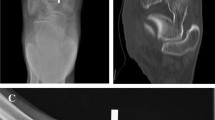Abstract
Introduction
Only few procedures for Lisfranc ligaments reconstruction to treat subtle injury of the Lisfranc joint have been reported. We have developed a novel technique for Lisfranc ligaments reconstruction, which was applied to treat chronic symptomatic subtle injuries that had failed to respond to initial treatment or were misdiagnosed. This article describes the technique and its operative outcome in a small case series.
Methods
Between April 2011 and October 2013, 5 (4 male and 1 female) athletes with a mean age of 19.4 (range 17–21) years were diagnosed with chronic subtle injury of the Lisfranc joint and underwent our novel reconstructive operation. In this technique, only a bone tunnel between the medial cuneiform and the second metatarsal bone is needed for near-anatomical reconstruction of the dorsal and interosseous ligaments. All patients were evaluated before and at 1 year after surgery using the American Orthopaedic Foot and Ankle Society (AOFAS) scale for the ankle–midfoot. In addition, the interval between surgery and return to athletic activity, defined as return to near pre-injury performance level, was investigated.
Results
Mean duration of postoperative follow-up was 18.8 (range 12–26) months. Mean AOFAS score improved significantly from 74.6 ± 2.5 (range 71–77) preoperatively to 96.0 ± 5.5 (range 90–100) at 1 year after the operation (p < 0.01). All patients were able to return to their previous athletic activities and the interval between surgery and return to athletic activity was 16.8 ± 1.1 (range 15–18) weeks. There was no complication related to the operation.
Conclusion
The results of this study suggest that our technique of Lisfranc ligaments reconstruction using autologous graft is effective for athletes with chronic subtle injury.
Level of evidence
Level IV, retrospective case series.





Similar content being viewed by others
References
Myerson MS, Cerrato RA (2008) Current management of tarsometatarsal injuries in the athlete. J Bone Joint Surg Am 90:2522–2533
Watson TS, Shurnas PS, Denker J (2010) Treatment of Lisfranc joint injury: current concepts. J Am Acad Orthop Surg 18:718–728
Faciszewski T, Burks RT, Manaster BJ (1990) Subtle injuries of the Lisfranc joint. J Bone Joint Surg Am 72:1519–1522
Curtis MJ, Myerson M, Szura B (1993) Tarsometatarsal joint injuries in the athlete. Am J Sports Med 21:497–502
Coss HS, Manos RE, Buoncristiani A, Mills WJ (1998) Abduction stress and AP weightbearing radiography of purely ligamentous injury in the tarsometatarsal joint. Foot Ankle Int 19:537–541
Nunley JA, Vertullo CJ (2002) Classification, investigation, and management of midfoot sprains: lisfranc injuries in the athlete. Am J Sports Med 30:871–878
Thordarson DB, Hurvitz G (2002) PLA screw fixation of Lisfranc injuries. Foot Ankle Int 23:1003–1007
Lee CA, Birkedal JP, Dickerson EA, Vieta PA Jr, Webb LX, Teasdall RD (2004) Stabilization of Lisfranc joint injuries: a biomechanical study. Foot Ankle Int 25:365–370
Alberta FG, Aronow MS, Barrero M, Diaz-Doran V, Sullivan RJ, Adams DJ (2005) Ligamentous Lisfranc joint injuries: a biomechanical comparison of dorsal plate and transarticular screw fixation. Foot Ankle Int 26:462–473
Lundeen G, Sara S (2009) Technique tip: the use of a washer and suture endobutton in revision lisfranc fixation. Foot Ankle Int 30:713–715
Brin YS, Nyska M, Kish B (2010) Lisfranc injury repair with the TightRope device: a short-term case series. Foot Ankle Int 31:624–627
Kitaoka HB, Alexander IJ, Adelaar RS, Nunley JA, Myerson MS, Sanders M (1994) Clinical rating systems for the ankle-hindfoot, midfoot, hallux, and lesser toes. Foot Ankle Int 15:349–353
Nery C, Réssio C, Alloza JF (2012) Subtle Lisfranc joint ligament lesions: surgical neoligamentplasty technique. Foot Ankle Clin 17:407–416
Hirano T, Niki H, Beppu M (2014) Newly developed anatomical and functional ligament reconstruction for the Lisfranc joint fracture dislocations: a case report. Foot Ankle Surg 20:221–223
de Palma L, Santucci A, Sabetta SP, Rapali S (1997) Anatomy of the Lisfranc joint complex. Foot Ankle Int 18:356–364
Conflict of interest
None.
Author information
Authors and Affiliations
Corresponding author
Rights and permissions
About this article
Cite this article
Miyamoto, W., Takao, M., Innami, K. et al. Ligament reconstruction with single bone tunnel technique for chronic symptomatic subtle injury of the Lisfranc joint in athletes. Arch Orthop Trauma Surg 135, 1063–1070 (2015). https://doi.org/10.1007/s00402-015-2250-6
Received:
Published:
Issue Date:
DOI: https://doi.org/10.1007/s00402-015-2250-6




